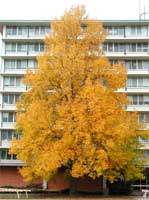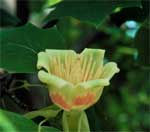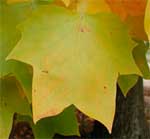Resource Library
Plant of the Week: Tulip, Poplar
The University of Arkansas System Division of Agriculture does not promote, support or recommend plants featured in "Plant of the Week." Please consult your local Extension office for plants suitable for your region.
Plant of the Week
Tulip Poplar
Latin: Liriodendron tulipifera

When Europeans first arrived on our continent, they were presented with a veil of greenery that seemed to stretch on forever. But, of course this was an illusion. In a twinkling it was gone, replaced by a manmade landscape with nature sublimated to serve the needs of humankind.
One of the first trees shipped back to Europe from this fragile green mantle was tulip poplar, Liriodendron tulipifera.
Like many of these early introductions, exact dates are uncertain, but Linnaeus cared for a tree planted in 1687 in his Leyden garden in Sweden. It was in England by at least 1663. John Bartram, the Colonial era botanist, began sending wholesale shipments of tree seeds to England in the early 1730's and tulip poplar was in most of his five guinea boxes.
The reason for its early introduction was its enormous size and wide range of distribution. It was hard to miss, being found throughout the eastern states from the Gulf Coast to the Canadian border. In Arkansas, according to the Atlas of Vascular Plants of Arkansas, which consists of county-level distribution maps of the 2,892 native and naturalized taxa of vascular plants known to occur outside of cultivation in Arkansas, Liriodendron tulipifera was found in 20 counties.
The primal forest of those early days must have been a thing to behold. In North Carolina’s Joyce Kilmer Memorial Forest, old growth tulip poplars are found with heights approaching 150 feet with 90 feet of trunk to the first branch. Trunks measure over 20 feet in circumference. Tulip poplar is the largest forest tree in the eastern woodlands.

Tulip poplars are also called Tuliptree, or in the timber trade, yellow poplar. The common name comes from the tulip shaped flowers borne at the ends of branches in late May. Flowers have the size and shape of a tulip with the greenish petals marked with orange near the base. Unfortunately, the blossoms are high in the tree, and unless you own a bucket truck, most people will never see them.
Tulip poplar leaves are unique in shape amongst all the North American trees. They are squarish in outline, and if blessed with a good imagination, resembles a tulip blossom in profile. In the fall, they turn a deep gold.

As a part of the mixed woodland, tulip poplars were used as an indicator species by early settlers. They grew on deep, well-watered and well drained soils that were perfect for farming. Lumber barons never made great fortunes off of tulip poplar like they did pines, but the wood has always been popular with builders, furniture makers and in making baskets.
In the landscape, tulip poplars present a problem. They’re so large they just don’t fit into the average suburban landscape. City parks, school grounds and farmlets in the country have room for them, but their value for suburbanites is limited. Trees are fast growing, but somewhat weak wooded, so don’t plant them too near the house.
The tall, straight trunk is a characteristic of forest-grown trees. When exposed to sunlight from all sides as they are in landscape situations, lower branches develop and trees become broad spreading with age. They’re not well suited for shallow, rocky soils or drought prone areas. Aphids often infest the trees during the summer, producing a black sooty mold on the leaves and a sappy mess on anything beneath the tree.
By: Gerald Klingaman, retired
Extension Horticulturist - Ornamentals
Extension News - January 20, 2006
The University of Arkansas System Division of Agriculture does not maintain lists of retail outlets where these plants can be purchased. Please check your local nursery or other retail outlets to ask about the availability of these plants for your growing area.